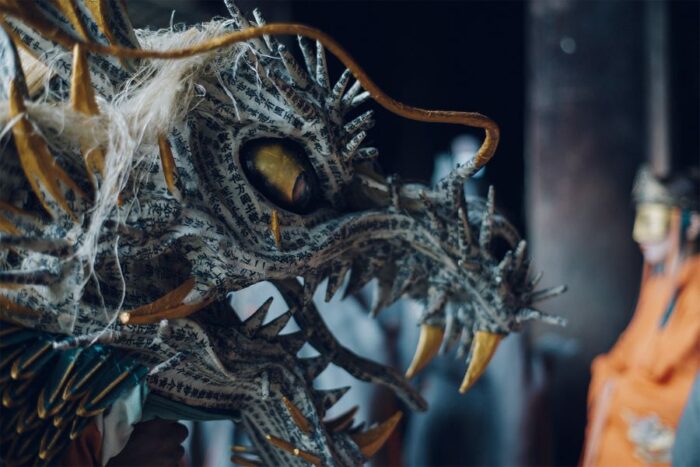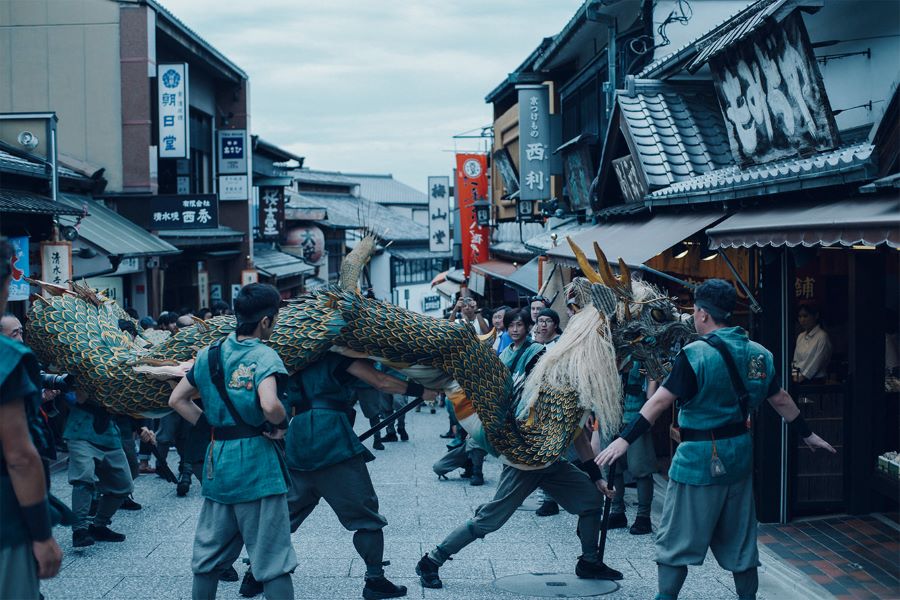Kyoto’s September festivals are a vibrant celebration of the city’s cultural heritage. The Kiyomizu-dera Seiryū-e, or Blue Dragon Festival, features a dynamic procession and a magnificent sutra-covered dragon. At the Chōyō no Sekku, or Chrysanthemum Festival, visitors can enjoy chrysanthemum-themed arts and crafts and participate in a crow sumo competition.

The Kangetsu no Yūbe offers a unique moon viewing experience on boats, while the Yoshitsune-sai pays tribute to the legendary warrior Yoshitsune with martial arts demonstrations. These festivals blend history, culture, and natural beauty, making them a must-see for both locals and travelers.
Key Takeaways
- Kiyomizu-dera Seiryū-e is a festival in Kyoto that honors the divine god-beast Seiryū, one of the four god-beasts protecting Kyoto’s borders.
- Chōyō no Sekku is a festival celebrated on September 9th at Kamigamo Shrine, featuring the appearance of Saiō-dai, a prayer dance, and a crow sumo competition.
- Kangetsu no Yūbe is a moon viewing party at Daikakuji Temple in early to mid-September, offering boat rides, tea room experiences, and the view of lotus flowers and the harvest moon.
- Yoshitsune-sai is an annual festival at Kurama-dera temple on September 15th, honoring the warrior Minamoto Yoshitsune with martial arts demonstrations and traditional dance performances.
Kiyomizu-dera Seiryū-e: The Blue Dragon Festival

The Blue Dragon Festival, known as Kiyomizu-dera Seiryū-e, is a vibrant procession held at Kiyomizu-dera in Kyoto. It features a large sutra-covered dragon and participants dressed in Chinese and Japanese costumes.
This festival was established in 2000 as a celebration of the divine god-beast Seiryū. Seiryū is one of the four god-beasts that protect Kyoto’s borders. Legends tell of a dragon visiting Kiyomizu-dera and drinking from the sacred waterfall. Seiryū is believed to be an incarnation of Kannon, the Buddhist goddess of mercy.

The procession is organized by monks and local groups. It starts from Kiyomizu-dera and winds its way through the neighborhood. Participants don a mix of Chinese and Japanese costumes. They showcase the magnificent dragon while musicians sound conch shells and priests cast holy water.
The Blue Dragon Festival is a colorful and enchanting event that pays homage to the powerful and protective spirit of Seiryū.
ChōYō No Sekku: the Chrysanthemum Festival
Participants of Chōyō no Sekku can witness a prayer dance and a crow sumo competition. This festival, celebrated on September 9th at Kamigamo Shrine in Kyoto, is a vibrant and auspicious event.
The number nine holds great significance in Japanese culture, symbolizing an excess of positive energy. The prayer dance, performed by participants in a mix of Chinese and Japanese costumes, is a captivating display of tradition and spirituality.
The crow sumo competition adds a touch of excitement and entertainment to the festivities. Chōyō no Sekku also pays tribute to the chrysanthemum, a flower that symbolizes youth and longevity. Visitors can admire chrysanthemum-themed arts and crafts, and women often wear kimonos adorned with chrysanthemum designs for good fortune.
Attending Chōyō no Sekku is a unique opportunity to immerse oneself in Japanese culture and celebrate the beauty of this beloved flower.
Kangetsu No YūBe: Moon Viewing Party at Daikakuji Temple
During the Kangetsu no Yūbe, visitors can float on boats around the Osawa pond and enjoy the enchanting view of lotus flowers during twilight and the moon after sunset. Here are four reasons why attending this moon viewing party at Daikakuji Temple in Kyoto is a must:
- Tranquil Boat Ride: Floating on the peaceful waters of Osawa pond provides a serene and magical experience. As you glide along, you’ll be surrounded by the delicate beauty of lotus flowers, their petals gently reflecting the fading light of the day.
- Moonlit Spectacle: As the sun sets and darkness envelops the landscape, the moon takes center stage. The moon’s soft glow casts a mesmerizing radiance on the pond, creating a breathtaking scene that is both enchanting and romantic.
- Delightful Tea Room: Inside Daikakuji Temple, you can take a break from the festivities and indulge in a traditional tea ceremony. Sip on matcha green tea and savor Japanese sweets while basking in the ambiance of the temple.
- Cultural Richness: Kangetsu no Yūbe is a celebration of both nature and Japanese tradition. Through this event, you’ll have the opportunity to immerse yourself in the cultural heritage of Kyoto, experiencing the blend of history, spirituality, and natural beauty that defines this enchanting city.
Yoshitsune-sai
Visitors at the annual Yoshitsune-sai festival can witness martial arts demonstrations, traditional dance performances, and the bustling atmosphere of Kurama-dera Temple. This vibrant event is held in Kyoto to honor the iconic warrior, Minamoto Yoshitsune.
Yoshitsune’s life is intertwined with tengu mythology, and this festival celebrates both his martial arts prowess and spiritual offerings. As you step into the main hall of Kurama-dera Temple, you’ll be enveloped in the aroma of incense and the mesmerizing sound of sutras being chanted in unison.
Martial arts enthusiasts will be captivated by the aikidō demonstrations, showcasing the skill and precision of the practitioners. And the traditional dance performances, presented as an offering to Yoshitsune, will transport you back in time.
As you make your way up the winding path to Kurama-dera, you’ll be immersed in the serene natural setting and enchanting temple structures, creating a truly authentic and peaceful festival experience.
For Japanese history enthusiasts, Yoshitsune-sai is a highly recommended event that brings history to life.
Hagi Matsuri
The Hagi Matsuri celebrates the bloom of hagi, also known as bush clover, and offers traditional Japanese arts and fall plants. This vibrant festival takes place from September 16th to 18th at Nashinoki Shrine in Kyoto.
As you wander through the festival grounds, you’ll be immersed in the beauty and fragrant aroma of the hagi flowers. The atmosphere is filled with creativity as members of the haiku society gather for creative sessions, writing poetry and tying their verses to the bush clover plants.
The festival also showcases the art of ikebana flower arrangement and mesmerizing solo dance performances. Visitors can experience the elegance of bugaku, the enchanting melodies of the shakuhachi flute and koto, and the precision of kyūdō demonstrations.
The Hagi Matsuri is a delightful celebration of nature, culture, and the arts, offering a truly enchanting experience.
Other September Festivals
Participants at the Hagi Matsuri in Kyoto can immerse themselves in the vibrant atmosphere of traditional Japanese arts and fall plants. The festival, hosted by Nashinoki Shrine, offers a variety of activities and performances that showcase the rich cultural heritage of Japan. Here are five highlights of the Hagi Matsuri:
- Haiku Society Creative Session: Join the local haiku society and unleash your creativity by writing poetry and tying them to the bush clover plants.
- Ikebana Flower Arrangement: Witness the artistry of ikebana, the traditional Japanese flower arrangement, as skilled practitioners demonstrate their craft.
- Solo Dance Performances: Be captivated by the grace and elegance of solo dance performances, where talented dancers bring traditional Japanese dances to life.
- Bugaku, Shakuhachi Flute, Koto, and Kyūdō Demonstrations: Experience the beauty of ancient Japanese performing arts through bugaku, shakuhachi flute, koto, and kyūdō demonstrations.
With its lively atmosphere and diverse range of activities, the Hagi Matsuri is a must-visit event for anyone seeking to immerse themselves in the beauty of Japanese culture.
Tips for Enjoying Kyoto’s September Festivals
After exploring the various September festivals in Kyoto, it’s time to delve into some tips for enjoying these vibrant and culturally rich events. Whether you’re planning to attend Kiyomizu-dera Seiryū-e, Chōyō no Sekku, Kangetsu no Yūbe at Daikakuji Temple, Yoshitsune-sai, or Hagi Matsuri, these tips will help make your experience even more memorable.
To provide a clear visual guide, here’s a handy table with four essential tips for each festival:
| Festival | Tips |
|---|---|
| Kiyomizu-dera Seiryū-e | 1. Arrive early to secure a good viewing spot for the parade. 2. Stay hydrated and bring a small snack for the duration of the procession. 3. Wear comfortable shoes as you will be walking through the neighborhood. 4. Capture the magical atmosphere by bringing a camera or smartphone to take photos. |
| Chōyō no Sekku | 1. Dress in traditional Japanese attire, such as a kimono, for a more immersive experience. 2. Witness the Saiō-dai prayer dance to appreciate the historical significance. 3. Try the chrysanthemum-themed arts and crafts and learn about their symbolic meaning. 4. Take part in the crow sumo competition for a fun and interactive experience. |
| Kangetsu no Yūbe | 1. Purchase boat tickets early to secure a spot for the best view of the moon. 2. Don’t miss the tea room inside Daikakuji Temple and savor the matcha green tea and Japanese sweets. 3. Experience the serene beauty of the Osawa pond by taking a boat ride. 4. Arrive early to explore the temple grounds and witness the special altar and offerings for a bumper crop. |
| Yoshitsune-sai | 1. Immerse yourself in the martial arts demonstrations, especially the aikidō performance. 2. Take time to explore the winding path up to Kurama-dera Temple and soak in the serene natural setting. 3. Attend the traditional dance performance as an offering to Yoshitsune and appreciate the artistry. 4. Learn about the historical significance of Yoshitsune’s life and his connection to tengu mythology. |
| Hagi Matsuri | 1. Participate in the haiku creative session and try your hand at writing poetry tied to the bush clover plants. 2. Observe the Ikebana flower arrangement and solo dance performances to appreciate traditional Japanese arts. 3. Immerse yourself in the Bugaku, shakuhachi flute, koto, and kyūdō demonstrations for a diverse cultural experience. 4. Embrace the changing performance offerings and discover new aspects of the festival each day. |
Frequently Asked Questions
What Is the Significance of the Number Nine in Japanese Culture and Why Is It Associated With ChōYō No Sekku?
The number nine holds significance in Japanese culture and is associated with Chōyō no Sekku. It represents an excess of positive energy and is considered auspicious. This festival celebrates the chrysanthemum’s medicinal properties and symbolizes youth and longevity.
How Can I Participate in the Saiō-Dai Prayer Dance at the ChōYō No Sekku Festival?
To participate in the Saiō-dai prayer dance at the Chōyō no Sekku festival, one can contact Kamigamo Shrine in Kyoto. They organize the festival and can provide information on how to get involved.
What Are Some Traditional Activities That Take Place During the Kangetsu No YūBe Moon Viewing Party at Daikakuji Temple?
During the Kangetsu no Yūbe moon viewing party at Daikakuji Temple, participants can float on boats around Osawa pond and enjoy the view of lotus flowers during twilight. There is also a quaint tea room inside the temple where visitors can savor matcha green tea and Japanese sweets.
What Is the Historical Background of Minamoto Yoshitsune and How Is It Commemorated During the Yoshitsune-Sai Festival?
Minamoto Yoshitsune, an iconic warrior, is honored during the Yoshitsune-sai festival at Kurama-dera temple in Kyoto. The festival commemorates Yoshitsune’s life, his battles, and his tragic demise, through martial arts demonstrations and traditional dance performances.
What Are Some Unique Performances and Activities That Visitors Can Expect at the Hagi Matsuri, Specifically at Nashinoki Shrine?
Visitors to the Hagi Matsuri at Nashinoki Shrine can expect unique performances and activities such as haiku sessions, Ikebana flower arrangements, solo dance performances, bugaku, shakuhachi flute, koto, and kyūdō demonstrations.
The Sum Up
To sum it up, Kyoto’s September festivals offer a captivating blend of tradition, beauty, and excitement. Whether it’s the mesmerizing Blue Dragon Festival, the enchanting Chrysanthemum Festival, the serene Moon Viewing Party, or the awe-inspiring Yoshitsune-sai, there is something for everyone to enjoy.
These festivals not only showcase the city’s rich cultural heritage but also provide a unique opportunity to immerse oneself in the vibrant atmosphere of Kyoto. So, if you find yourself in Kyoto in September, make sure to experience these unforgettable events and create memories that will last a lifetime.




